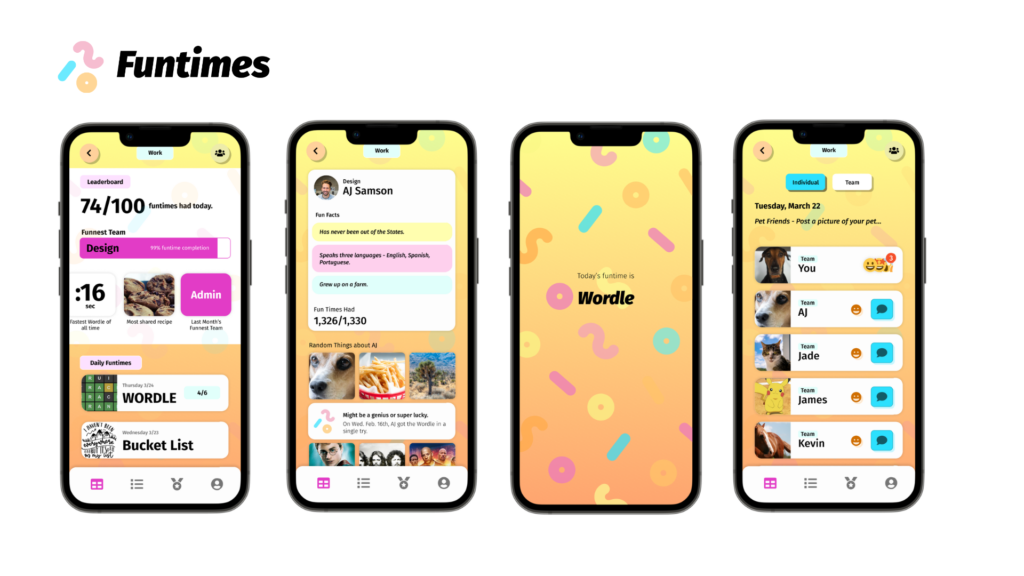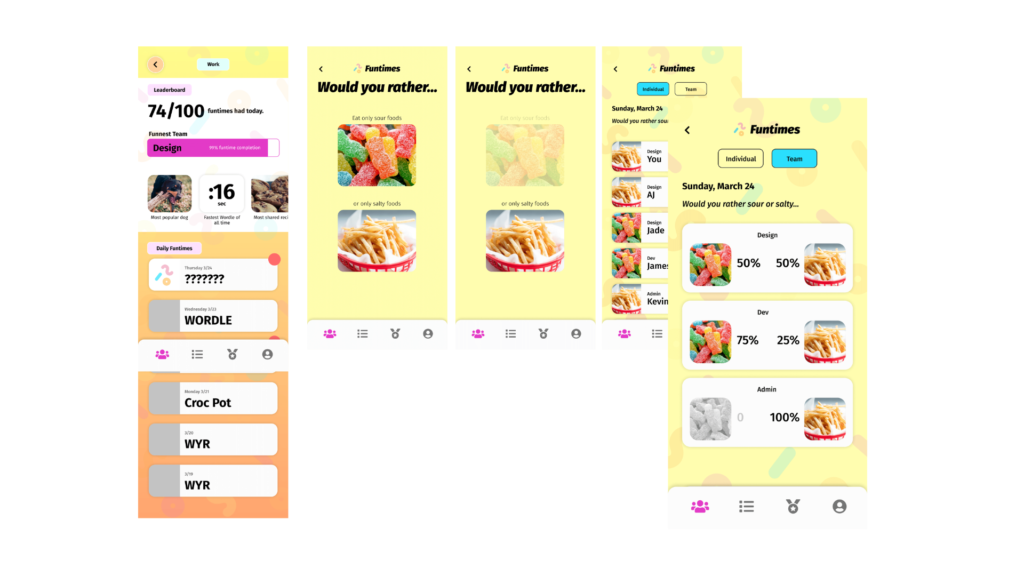
TLDR Verison Launch the Prototype
Over the pandemic, three new designers joined my remote team. One of my biggest concerns was finding a way for my new teammates to feel welcomed and for us to bond. Back at the office, there were always opportunities to chat in the break room, learn about each other’s hobbies, go to happy hour, create inside jokes and get to know each other.
The Problem:
While some companies have begun to invite workers to return to their offices, many have decided to maintain work-from-home policies to eliminate the cost of a physical office. Over nine interviews with remote workers, I confirmed this situation has had a negative impact on company culture and many workers do not feel like they are part of a team. Since going remote, conversations that were once organic, now require effort to initiate – clicking into the Teams chat, finding the person you want to talk to, and then striking up the courage to send them a direct message about something completely un-work related. It is simply easier, less frightening, and less work to just…not.
Leading me to ask, how might we create a remote environment where conversations can organically occur to promote team bonding?
Findings from Interviews:
In addition to uncovering the problem, I also found inspiration. Amidst the responses of feeling disconnected, there were some who experienced an increase in communication and bonding. These interviewees had all mentioned being part of a frequent, simple, short, non-work related activities.
For example, the phenomenon of Wordle. Numerous interviewees stated that each day they do the Wordle, submit their scores and then razz each other in a Slack channel or iMessage about their success or failure.
As a second example, an interviewee mentioned that each member of their team filled out a short survey with simple, silly questions. The answers are tallied and then shared with the entire team. Responses would spark interest of one or more team members and a conversation would be started often ending in laughs and jokes.
Another interviewee mentioned that their team always starts meetings with ice breakers of topics that are not related to their industry. The interviewee reported the ice breakers were a good reminder that their team members were “people first” – one of their company’s core values.
Competitive Research:
Competitive research on existing direct and in direct products. I identified three categories of competing products and conducted more interviews about how people felt about the solutions currently in the market.
People liked the idea of conversation starters, such as Donut.com which can be added to existing chat channels as an automated conversation starter. At the same time, many of the interviews stated that replying in a chat where people are notified instantly was nerve racking similar to speaking on a stage.
Social media, though built exactly for participating in a social network, was not readily shared nor did people feel comfortable asking their co-workers for their accounts. Many interviewees stated there have been times they posted things they didn’t want their co-workers, let alone managers, to see.
Random standalone games, ice breaker generators, or surveys (like BuzzFeed surveys) shared and played across teams seemed to be good solutions for occasional activities. However, they often required manual resourcing and facilitation. A few of the employees also stated there were a few times they felt left out because they hadn’t been included in some of the activities.
Concept/Lo-Fi Sketches and Wire Frames
Based on the competitive research and interviews, I sketched up an idea for a mobile application to help facilitate and manage an experience for co-workers to bond. The application provides a prompt for a simple, short, non-work related activity. The results of this activity are displayed in a group setting for everyone to see, react to or leave comments on. The intent is to allow frequent, shared experiences between coworker’s without putting them on a stage or requiring them to share all of their personal lives.

Feature Validation/Usability Testing:
Once I had the initial concept completed, I showed my design to a handful of individuals to validate and gather feedback on the application feature set and to test usability.
Key feedback on each flow:
- Participating in a daily funtime.
- Positive reaction to the daily cadence.

- Viewing a reaction.
- Would like to see other peoples reactions to everyone’s score
- Reacting to a coworker’s post.Giving just one reaction good enough
- Want to see what his guesses were, also would be ok sharing their guesses. Ok with only being able to see the results for today’s funtime.
- Suggested stacking emojis to show multiple reactions on a post.
- More likely to respond with comment in app rather than chat in separate chat, because more comfortable replying in same space with others (not DMing).

- Viewing the dashboard and stats by teams.
- Less emphasis on stat overview
- Dashboard highlights need group tags
- Put number in red notification dot to indicate that it is a notification
- WYR – likes team stats
- Would like to see colored bars in addition to %s
- Likes the team details view
- Maybe a short reason about why you chose each thing

- Other feedback:
- Designing for mobile was appreciated. Photos are more accessible to post.
- Some other activities that people thought would be fun:
- Music
- Movies
- Bucket lists
- Foods
- Never leaves without
- Firsts
- Ridiculous Quizzes (Buzz feed quizzes)
- Short story (travel gone wrong, first time left country)
- Best Halloween costume
- Kid picture
- Menu – dashboard icon (squares, speedometer)
- Requested the ability to customize notifications
Branded, Hi-Fi Prototype
I named the application Funtimes based on the idea of FOMO (Fear of missing out). When people are having a fun time without you, you want to be a part of it. You want to hang out. When an individual receives a notification stating “You have a fun time waiting for you.” or “Your coworkers are having a fun time.” hopefully they are motivated to join in!
I chose funky, but simple shapes and a bold, chunky interface so that while in the app, user’s feel like its time to play, not work.

Next Steps:
With the help of the user interviews, I feel confident in the current concept of Funtimes as a viable solution to remote bonding. The next steps for me would be:
- Designing the flow and UI for administrative tasks such as setting up teams, groups, and adjusting personal user settings like notifications.
- Designing the UI for other types of activities.
- Adding more activities and activity features, such as playing together in real time, employee prizes and giveaways, and optional direct messaging.
- Adding a rules of engagement screen.
- Adding function for users to provide feedback.
- Writing user stories.
- Developing a project timeline.
- Continue testing and iterating to solidify an MVP.
- and finally, finding a team to build!
Thanks for checking out my capstone project!